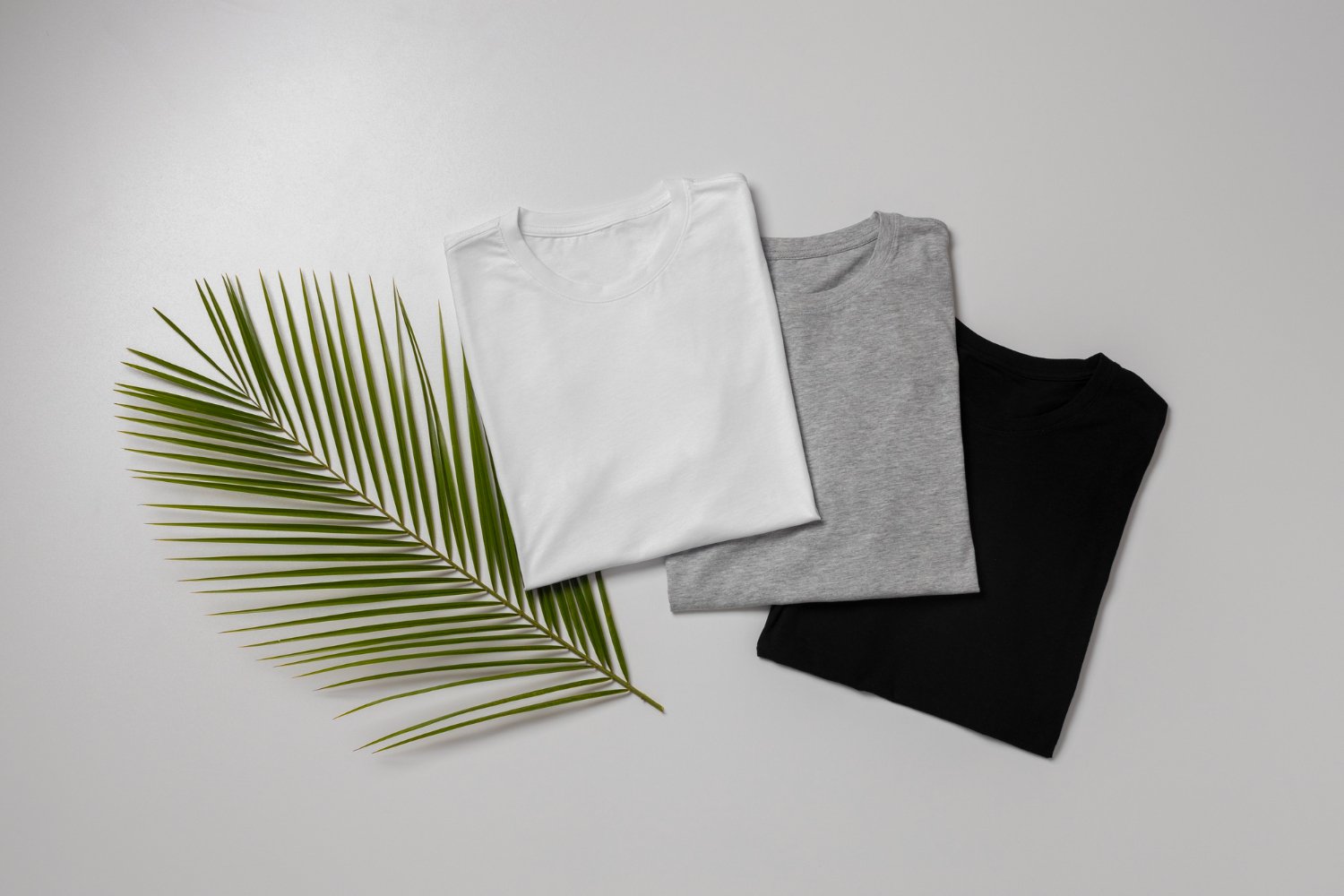Ever put on a brand new tee, only to have it feel… just wrong? Maybe it’s stiff, or it loses its shape after one wash, or it just doesn’t quite drape the way you imagined. We’ve all been there. That moment of disappointment when your eagerly awaited T-shirt doesn’t live up to expectations. But what if your favorite T-shirt could feel like a dream, a true second skin that moves with you, feels amazing all day long, and maintains its charm through countless adventures? The secret, my friends, lies not just in the design, but profoundly in the fabric. And trust us, once you unlock the nuances of T-shirt textiles, you’ll never look at a T-shirt the same way again. You’ll become a discerning connoisseur, capable of choosing comfort, style, and longevity with confidence.
For style-conscious young adults like you, a T-shirt isn’t just a basic; it’s a canvas for self-expression, a statement of comfort, and a reflection of your personal brand. Understanding the materials that make up your favorite tees is crucial for making informed choices that align with your lifestyle and values. Let’s dive deep into the wonderful world of T-shirt textiles and uncover what makes each one special, so you can pick the perfect tee for every mood, moment, and occasion.
The Core Contenders: A Fabric Face-Off
1. 100% Cotton: The Timeless Classic and Its Many Faces
Ah, 100% cotton. It’s the OG, the tried-and-true foundation of countless wardrobes across generations. When you think of a classic cotton tee, you’re probably picturing its signature feel: incredibly breathable and wonderfully natural against your skin. It’s that familiar, comforting softness that makes it an everyday comfort staple, a go-to for casual days, lounging, or layering. But not all cotton is created equal, and understanding its variations can elevate your T-shirt game significantly.
What Makes Cotton Special?
Cotton is a natural fiber derived from the cotton plant. Its structure allows for excellent air circulation, making it a highly breathable fabric. This breathability is key to keeping you cool and comfortable, especially in warmer climates or during light activity. Furthermore, cotton fibers are naturally absorbent, which means they can wick away moisture from your skin, contributing to that fresh feeling. For those with sensitive skin, cotton is often a preferred choice due to its hypoallergenic properties, minimizing irritation [1, 2].
Variations of Cotton:
* Standard Cotton: This is your basic, most common cotton. It’s soft and durable but can be prone to shrinking and wrinkling.
* Ringspun Cotton: Made by continuously twisting and thinning cotton strands, ringspun cotton produces a much finer, stronger, and softer yarn. Ringspun T-shirts feel significantly softer and are more durable than standard cotton tees.
* Combed Cotton: This takes ringspun cotton a step further. After the fibers are spun, they are literally combed to remove any short fibers and impurities. The result is an even softer, stronger, and more luxurious fabric. Combed cotton is often used for high-quality apparel.
* Organic Cotton: Grown without synthetic pesticides, herbicides, or fertilizers, organic cotton is an environmentally friendly choice. It retains all the natural benefits of cotton while being better for the planet and often for sensitive skin.
Pros:
* Unmatched Softness & Absorbency: Cotton fibers are naturally soft and excel at absorbing moisture, making it incredibly comfortable, especially in warmer weather or for those prone to sweating [1]. This absorbency also makes it a great base for dyeing, resulting in rich, deep colors.
* Superior Breathability: Its natural fibers allow air to circulate freely, acting like a natural air conditioner to keep you cool and prevent that clammy feeling.
* Hypoallergenic & Skin-Friendly: Generally gentle on sensitive skin, cotton minimizes the risk of irritation or allergic reactions, making it a safe choice for everyday wear [2].
* Versatile & Affordable: Available in a wide range of qualities and price points, making it accessible for various budgets and uses.
Cons:
* Prone to Shrinkage: Cotton is notorious for shrinking, especially if exposed to high heat during washing or drying [1]. Always check care labels and consider air drying or low-heat tumble drying.
* Wrinkles Easily: While part of its natural charm, cotton can wrinkle more readily than synthetic blends, requiring more ironing or steaming for a crisp look.
* Takes Time to Dry: Due to its high absorbency, cotton can take longer to dry once wet, which might be a drawback for active wear or quick laundry cycles.
* Can Lose Shape: Over time, especially with frequent washing and wear, 100% cotton can sometimes lose its original shape or stretch out.
Care Tips for 100% Cotton:
To keep your 100% cotton tees looking their best and minimize shrinkage, follow these guidelines:
* Wash: Machine wash in cold water with similar colors. Cold water helps prevent shrinking and fading. Turn your T-shirt inside out before washing to protect the fabric and any prints or embellishments.
* Detergent: Use a mild detergent. Avoid harsh chemicals and chlorine bleach, as they can weaken cotton fibers and cause discoloration.
* Dry: Air dry by laying flat on a clean surface or hanging on a padded hanger. If using a dryer, tumble dry on low heat. High heat is cotton’s enemy when it comes to shrinkage [1]. Remove promptly to prevent excessive wrinkling.
* Ironing: Iron on a medium-high setting while the garment is slightly damp, or use a steam iron. Iron inside out to protect any prints.
2. Cotton-Polyester Blend: The Durable Workhorse
Meet the cotton-polyester blend, often seen in ratios like 50/50, 60/40, or 65/35, but the exact mix can vary. This blend was ingeniously created to combine the best qualities of both natural cotton and synthetic polyester. It’s the workhorse fabric of the T-shirt world, designed for durability, practicality, and a balance of comfort and performance. It feels softer than pure polyester but benefits immensely from polyester’s inherent strength and resilience.
Why the Blend?
The primary reason for blending cotton with polyester is to mitigate cotton’s weaknesses (shrinkage, wrinkling, drying time) while enhancing its strengths (softness, breathability). Polyester, a synthetic fiber, is known for its strength, resistance to stretching and shrinking, and quick-drying properties. When combined with cotton, it creates a fabric that is more robust, easier to care for, and maintains its appearance longer [3].
Pros:
* Exceptional Durability & Shape Retention: The polyester content significantly boosts the fabric’s strength, making it more resistant to wear and tear, stretching, and shrinking. This means your tee will hold its shape, even after countless washes, making it a long-lasting choice [3].
* Less Shrinkage & Wrinkling: One of the biggest advantages is its resistance to shrinking and wrinkling. This blend keeps your tee looking fresh and neat with minimal effort, reducing the need for ironing.
* Quick-Drying: Polyester’s moisture-wicking properties contribute to a faster drying time compared to 100% cotton, which is great for active lifestyles or when you need a quick turnaround on laundry.
* Ideal for Graphic Prints: The smooth, stable surface of cotton-polyester blends makes them an excellent canvas for vibrant, detailed graphic tees. The colors tend to pop and last longer without fading or cracking.
Cons:
* Reduced Breathability: While still comfortable, the polyester component makes it less breathable than pure cotton. This can be a consideration in very hot and humid conditions, as it might feel slightly warmer.
* Less Natural Feel: Some individuals might find the fabric less soft or natural-feeling compared to the pure, soft touch of 100% cotton. The hand-feel can vary depending on the blend ratio and quality of the fibers.
* Can Retain Odors: Synthetic fibers like polyester can sometimes trap odors more easily than natural fibers, requiring specific washing techniques to keep them fresh.
Care Tips for Cotton-Polyester Blend:
This blend is relatively low-maintenance, but a few tips can help extend its life:
* Wash: Machine wash in cold or warm water with a mild detergent. Cold water is generally safer for colors and prints, while warm water can be used for whites. Use a gentle or normal cycle. Avoid using chlorine bleach, as it can damage the polyester fibers and affect colors.
* Dry: Tumble dry on low heat or, ideally, line dry. The blend’s quick-drying nature makes line drying efficient. High heat can still cause some minimal shrinkage or damage to the fibers over time.
* Ironing: Iron on a low to medium setting if needed. Avoid direct, high heat on any printed areas, as it can melt or damage the print. Iron inside out if possible.
3. Tri-Blend: The Luxury Touch and Ultimate Comfort
If you’re looking for the ultimate in comfort, softness, and a distinct style, say hello to the tri-blend. This fabric is typically a sophisticated mix of three materials: cotton, polyester, and rayon. It’s truly the luxury option in the T-shirt world, offering an unparalleled feel and drape that you’ll fall in love with instantly. Tri-blends are celebrated for their unique combination of properties, creating a garment that feels premium from the moment you put it on.
The Magic of Three:
* Cotton: Provides the natural softness, breathability, and familiar comfort.
* Polyester: Adds durability, reduces shrinkage, and helps the garment maintain its shape and vibrant colors.
* Rayon: This semi-synthetic fiber (made from regenerated cellulose fibers like wood pulp) is the secret ingredient. Rayon is known for its exceptional softness, smooth texture, and beautiful drape. It mimics the feel of silk, adding a luxurious, fluid quality to the fabric [4].
Together, these three fibers create a harmonious blend that offers the best of all worlds.
Pros:
* Incredibly Soft & Luxurious Feel: Rayon is the star here, contributing an exceptional softness and smoothness that makes the fabric feel amazing against the skin. It’s often described as having a silky, almost buttery texture.
* Slightly Vintage, Worn-in Feel: From the moment you put it on, a tri-blend tee often has that perfect, lived-in feel as if it’s been your favorite tee for years. This characteristic gives it a cool, effortless, and slightly retro vibe that many style-conscious individuals adore.
* Lightweight & Drapey: Tri-blends are renowned for their beautiful drapey quality, creating a flattering silhouette that feels lightweight and effortless. This makes them ideal for a more relaxed yet refined look, perfect for layering or standing alone.
* Durable & Less Prone to Shrinkage: The polyester content contributes significantly to its durability and helps prevent excessive shrinking, ensuring your premium tee maintains its shape and size over time.
* Breathable (with a caveat): While not as breathable as 100% cotton, the blend still offers a good level of comfort, especially with the natural fibers of cotton. The rayon also contributes to a comfortable feel.
Cons:
* Can Be More Expensive: Due to the blend of premium materials and the sophisticated manufacturing process, tri-blends often come with a higher price tag. However, many find the superior comfort and style worth the investment.
* Less Absorbent than Cotton: While rayon itself can be absorbent, the overall blend might not wick moisture as effectively as pure cotton, especially during intense physical activity. It’s generally not the first choice for high-performance athletic wear.
* Delicate Care: To maintain its luxurious feel and drape, tri-blends often require a bit more careful handling during washing and drying.
Care Tips for Tri-Blend:
To preserve the incredible softness and drape of your tri-blend tees, gentle care is key:
* Wash: Machine wash in cold or lukewarm water to preserve fabric integrity and prevent damage to the delicate rayon fibers. Turn your T-shirt inside out before washing to protect the fabric and any prints.
* Detergent: Use a mild detergent. Avoid harsh chemicals, bleach, and fabric softeners, as these can degrade the fibers and affect the fabric’s feel.
* Dry: Hang dry or tumble dry on low heat. High heat is the enemy of rayon and can cause it to lose its shape or become stiff. Air drying is always the safest bet to maintain shape and prevent pilling.
* Ironing: Iron on a very low setting if necessary, preferably inside out. Avoid high heat.
Understanding Fabric Weight: Light vs. Substantial
Beyond the fiber content, fabric weight plays a huge role in how a T-shirt feels, performs, and looks. Simply put, it refers to how dense or heavy the fabric is. It’s usually measured in ounces per square yard (oz/yd²) in the US or grams per square meter (gsm) internationally. This isn’t just a technical detail; it directly impacts the drape, durability, and suitability of a T-shirt for different climates and styles.
- Heavier fabrics (think 6 oz/yd² or more, or 200+ gsm) feel more substantial and structured. They often offer more warmth, have a more opaque look, and can feel more premium and durable. These are great for cooler weather, a more formal T-shirt look, or when you want a tee that feels robust.
- Lighter fabrics (around 3-4 oz/yd², or 100-150 gsm) are breezier and more airy. They offer a more relaxed, flowing fit and are perfect for warmer climates, layering, or when you desire a barely-there feel. These often have a softer, more delicate drape.
So, a heavier fabric feels more substantial, while a lighter one is breezier. It’s all about personal preference and what you’re looking for in your tee! Consider the climate you’ll be wearing it in and the overall aesthetic you’re aiming for.
Comprehensive Fabric Comparison Table
To help you visualize the differences, here’s a quick comparison of our main contenders:
| Feature / Fabric | 100% Cotton | Cotton-Polyester Blend | Tri-Blend |
|---|---|---|---|
| Feel | Soft, natural, breathable | Softer than pure poly, durable, holds shape | Incredibly soft, lightweight, drapey, vintage feel |
| Breathability | Excellent | Good | Very Good |
| Durability | Good (can be prone to stretching/shrinking) | Excellent (resists wear, tear, shrinkage) | Excellent (resists wear, tear, shrinkage) |
| Shrinkage | High (if not cared for properly) | Low | Low |
| Wrinkle Resist. | Low | High | Medium-High |
| Drying Time | Slow | Fast | Medium |
| Print Quality | Good (absorbs ink well) | Excellent (stable surface, vibrant colors) | Good (can have a slightly faded/vintage print look) |
| Cost | Affordable to Medium | Affordable to Medium | Medium to High |
| Best For | Everyday comfort, casual wear, sensitive skin | Active wear, graphic tees, uniforms, durability | Premium comfort, fashion-forward looks, lived-in feel |
So, Which One Is For You? Matching Fabric to Your Lifestyle
Choosing the right T-shirt fabric really comes down to your lifestyle, what you’re doing, and what feel you prefer. There’s no single “best” fabric—only the best fabric for you. Here’s a more detailed guide to help you decide:
For the Purist Who Values Everyday Comfort & Classic Style:
If your ideal T-shirt is one that feels soft, natural, and gets better with age, you’re a 100% Cotton person. You appreciate the timeless appeal of a classic tee that you can wear for a casual coffee run, a weekend hangout, or as a comfortable base layer. You don’t mind a bit of wrinkling, as it adds to the relaxed charm, and you’re diligent about your laundry routine to keep your tees in great shape. Your style is effortless, grounded, and authentic.
Your Go-To: A high-quality, ringspun or combed 100% cotton tee.
For the Active Individual Who Needs Durability & Performance:
If you’re always on the go, hitting the gym, or need a T-shirt that can keep up with your busy life without looking worn out, the Cotton-Polyester Blend is your best friend. You value practicality and need a tee that resists wrinkles, holds its shape, and dries quickly. You might also be a fan of bold, vibrant graphic tees, and you want those designs to stay crisp and clear. You need a workhorse that looks as good at the end of the day as it did at the beginning.
Your Go-To: A 50/50 or 60/40 cotton-polyester blend tee.
For the Connoisseur of Comfort Who Seeks a Premium, Lived-in Feel:
If you believe that comfort is the ultimate luxury and you want your T-shirts to feel like a soft, gentle hug, you’ll fall in love with a Tri-Blend. You’re drawn to fabrics that have a beautiful drape and a slightly vintage, effortlessly cool vibe. You don’t mind investing a bit more for a superior feel and a more fashion-forward look. Your style is all about understated luxury and feeling amazing in what you wear.
Your Go-To: A premium tri-blend tee.
Fabric Care at a Glance
Proper care is essential to extending the life of your favorite tees. Here’s a quick-reference table for washing and drying your T-shirts based on their fabric type:
| Care Instruction | 100% Cotton | Cotton-Polyester Blend | Tri-Blend |
|---|---|---|---|
| Washing Temp. | Cold water is best to prevent shrinkage and fading. | Cold or warm water. | Cold or lukewarm water to protect delicate rayon fibers. |
| Detergent | Mild detergent. Avoid bleach. | Mild detergent. Avoid bleach. | Mild detergent. Avoid bleach and fabric softeners. |
| Drying | Air dry (hang or lay flat) or tumble dry on low heat. | Tumble dry on low heat or line dry. | Air dry (hang or lay flat) or tumble dry on low heat. |
| Ironing | Medium-high heat, preferably inside out. | Low to medium heat, inside out, avoiding prints. | Very low heat, inside out. |
Now that you’re armed with this in-depth fabric knowledge, you’re ready to make informed choices and curate a T-shirt collection that truly serves your style and comfort needs. Why not feel the difference for yourself? Browse the Teenetwork.co collection today and discover the perfect fabric that speaks to you. Your next favorite T-shirt is waiting.
References
[1] Printify. (2025, June 11). T-shirt fabric guide: What is the best fabric for t-shirts? https://printify.com/blog/t-shirt-fabric-guide/
[2] Printful. (2024, March 22). Polyester vs. Cotton Shirts—Pros, Cons, and Printing Options. https://www.printful.com/blog/polyester-vs-cotton-shirts
[3] Merchize. (2024, January 5). Cotton Polyester Blend Explained: Pros, Cons, Applications. https://merchize.com/cotton-polyester-blend/
[4] Ninja Transfers. (n.d.). Types Of Shirt Materials | A Guide To Apparel Fabrics. https://ninjatransfers.com/pages/types-of-shirt-material




